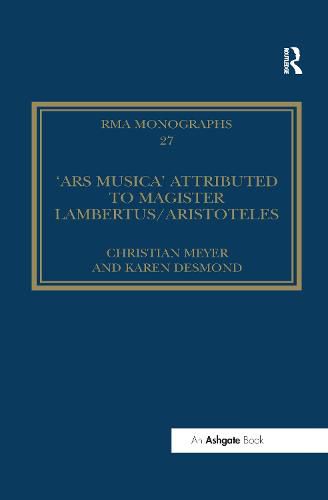Readings Newsletter
Become a Readings Member to make your shopping experience even easier.
Sign in or sign up for free!
You’re not far away from qualifying for FREE standard shipping within Australia
You’ve qualified for FREE standard shipping within Australia
The cart is loading…






The treatise on musica plana and musica mensurabilis written by Lambertus/Aristoteles is our main witness to thirteenth-century musical thought in the decades between the treatises of Johannes de Garlandia and Franco of Cologne. Most treatises on music of this century - except for Franco’s treatise on musical notation - survive in only a single copy; Lambertus’s Ars musica, extant in five sources, is thus distinguished by a more substantial and long-lasting manuscript tradition. Unique in its ambitions, this treatise presents both the rudiments of the practice of liturgical chant and the principles of polyphonic notation in a dense and rigorous manner like few music treatises of its time - a conceptual framework characteristic of Parisian university culture in the thirteenth century. This new edition of Lambertus’s treatise is the first since Edmond de Coussemaker’s of 1864. Christian Meyer’s meticulous edition is displayed on facing pages with Karen Desmond’s English translation, and the treatise and translation are prefaced by a substantial introduction to the text and its author by Christian Meyer, translated by Barbara Haggh-Huglo.
$9.00 standard shipping within Australia
FREE standard shipping within Australia for orders over $100.00
Express & International shipping calculated at checkout
The treatise on musica plana and musica mensurabilis written by Lambertus/Aristoteles is our main witness to thirteenth-century musical thought in the decades between the treatises of Johannes de Garlandia and Franco of Cologne. Most treatises on music of this century - except for Franco’s treatise on musical notation - survive in only a single copy; Lambertus’s Ars musica, extant in five sources, is thus distinguished by a more substantial and long-lasting manuscript tradition. Unique in its ambitions, this treatise presents both the rudiments of the practice of liturgical chant and the principles of polyphonic notation in a dense and rigorous manner like few music treatises of its time - a conceptual framework characteristic of Parisian university culture in the thirteenth century. This new edition of Lambertus’s treatise is the first since Edmond de Coussemaker’s of 1864. Christian Meyer’s meticulous edition is displayed on facing pages with Karen Desmond’s English translation, and the treatise and translation are prefaced by a substantial introduction to the text and its author by Christian Meyer, translated by Barbara Haggh-Huglo.